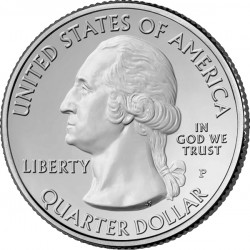
Released as the fourth 2014 strike of the US Mint’s America the Beautiful Silver Bullion Coin™ Program will be the 2014 Great Sand Dunes America the Beautiful Silver Bullion Coin. It also marks the twenty-fourth release out of fifty-six that are due under the terms of the program which launched in 2010 and ends in 2021.
An edge inscription will be placed on each bullion coin indicating its weight and fineness. In this case, the weight is five ounces of .999 fine silver. The coin will be struck to a diameter of three inches.
These coins were authorized as part of the America’s Beautiful National Parks Quarter Dollar Coin Act of 2008 which also created circulating quarters. Both series (the bullion and the quarters) will feature similar designs on their reverse, with a portrait of George Washington gracing the obverse.
Great Sand Dunes National Park in Colorado will be showcased on the reverse of this particular strike. A final design has not yet been chosen but design candidates should appear early in 2013 to be reviewed by the appropriate groups including the Citizen’s Coinage Advisory Committee and the Commission of Fine Arts. The Act authorizing the coins dictates that the Treasury Secretary will make the final selection.
The complete America the Beautiful Silver Bullion program will consists of one strike from each state, the District of Columbia and the five US territories – Guam, US Virgin Islands, Puerto Rico, American Samoa and the Northern Mariana Islands. These strikes will showcase a site of national interest located within that jurisdiction and may honor a national park, national memorial, national forest, etc.
As normal for bullion pieces from the Mint, they will only be sold by the Mint to a network of authorized purchasers. These purchasers will then resell them to coin dealers and individuals for a small mark-up over the current spot price of the five ounces of silver contained within them.
Coins honoring Great Smoky Mountains National Park in Tennessee, Shenandoah National Park in Virginia and Arches National Park in Utah will precede this Great Sand Dunes strike in 2014. It will be followed by one more coin that year which showcases Everglades National Park in Florida.
Great Sand Dunes National Park in Colorado
The Great Sand Dunes National Park in Colorado protects a system of dunes that is not only considered the tallest in North America but also one of the most fragile and complex in the world.
Contrary to what many believe, the system is far from being void of water. In fact, it is the presence of water in and around the dunes that keep the regenerative cycle going. If one were to dig down only a few feet, even at the dunes peak, you would start to find moist sand. The presence of this moisture prevents the entire dunes from blowing away. The top layer, however, does get blown off of the dunes, only to be caught up in a series of streams that surrounds them. These streams also slowly erode at the edge of the dunes as they pass by. As these streams slowly dry up the further they progress from their source, the sand they have caught gets blown back up onto the dunes, completing a full circle.
Included in the parks boundaries in addition to the dunes are several alpine lakes, ancient spruce and pine forests, high peaks over 13,000 feet in elevation and even some wetlands. This diverse collection of attractions draws over a quarter of a million visitors annually.
The area first caught the official attention of the federal government in 1932 when it was named a national monument which provided a level of protection to the fragile system. In 2000, the Great Sand Dunes National Park and Preserve Act of 2000 was signed into law and led to a purchase of 97,000 acres of land of which a portion was used to triple the size of the monument. Finally, in 2004 the Great Sand Dunes National Park and Preserve was created.
Visitors should prepare for many types of weather, especially if they plan on traversing some of the landscape. Those wanting to climb the dunes will have to cross the Medano Creek which typically only flows from spring until early summer.